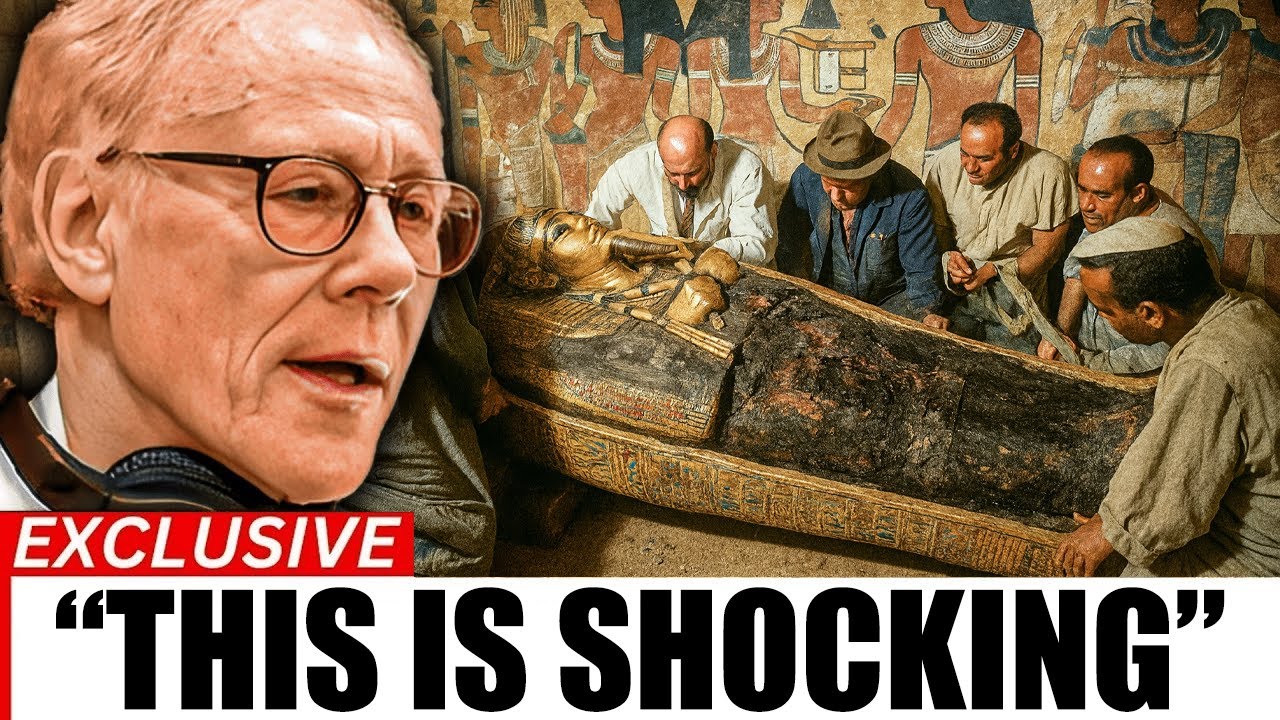🔥 The boy king’s golden mask hides a SHOCKING secret that could rewrite history! 🔥
DNA cracked open Tutankhamun’s tomb, exposing a twisted royal scandal—sibling love, cursed bloodlines, and a frail pharaoh doomed at 19. 😱 His pain echoes in our genes today… Uncover the dark truth behind Egypt’s greatest treasure! 👉

For over a century, the golden mask of Tutankhamun has captivated the world, symbolizing the opulence and mystery of ancient Egypt. But beneath the treasures unearthed by Howard Carter in 1922 lies a darker tale: a boy pharaoh whose short life was marred by physical frailty, infectious disease, and the genetic shadows of royal incest. A groundbreaking DNA analysis, revisited in light of advanced sequencing techniques marking the centennial of the tomb’s discovery, has peeled back layers of speculation to confirm long-held suspicions about the 18th Dynasty’s tangled family tree. The results, drawing on the landmark 2010 study published in the Journal of the American Medical Association (JAMA) and bolstered by recent genetic modeling, paint a picture of a dynasty crumbling under its own weight of inbreeding and misfortune.
The original research, led by Egypt’s former antiquities chief Zahi Hawass in collaboration with German geneticist Carsten Pusch, examined DNA from 11 royal mummies, including Tutankhamun’s own remains. Using techniques like polymerase chain reaction (PCR) to amplify short tandem repeats—genetic markers akin to fingerprints—the team constructed a five-generation pedigree. This wasn’t mere academic curiosity; it was a forensic quest to humanize the pharaohs, revealing not gods on earth but vulnerable humans plagued by the consequences of their divine pretensions.
At the heart of the revelation: Tutankhamun’s parents were full siblings. The mummy from tomb KV55—long suspected to be Akhenaten, the revolutionary father who upended Egypt’s polytheistic traditions for a monotheistic cult of the sun god Aten—was confirmed as Tut’s dad. His mother, identified as the “Younger Lady” from KV35, was Akhenaten’s sister, an unnamed daughter of the powerful couple Amenhotep III and Queen Tiye. This brother-sister union, a practice rooted in the pharaohs’ belief that only the purest blood could sustain the gods’ favor, backfired spectacularly. “The accumulation of genetic defects in Tutankhamun’s family was evident,” the JAMA study noted, linking the incest to a cascade of health woes that hobbled the boy king from birth.
Tutankhamun ascended the throne around age nine, following the chaotic interregnum of his father’s rule. Akhenaten’s radical reforms—closing temples, smashing idols, and relocating the capital to Amarna—had alienated the priesthood and nobility, leaving the empire unstable. The boy pharaoh, originally named Tutankhaten in honor of his father’s deity, swiftly restored traditional worship, changing his name to Tutankhamun (“living image of Amun”) and returning the court to Thebes. Yet his reign, lasting just a decade, was more puppet show than power play, guided by viziers like Ay and Horemheb.
But the DNA doesn’t just map lineage; it maps suffering. Tut’s genome revealed no evidence of exotic syndromes like Marfan or Antley-Bixler, debunking sensational theories of elongated skulls or gynecomastia that once fueled tabloid speculation about Akhenaten’s “feminine” depictions in art. Instead, the pharaohs’ maladies were prosaic yet devastating: bone necrosis, clubfoot, and a predisposition to infections amplified by weakened immunity from inbreeding. Tut himself suffered from Köhler disease II, a juvenile form of avascular necrosis that starved his foot bones of blood, leaving him reliant on canes—over 130 of which were found in his tomb, not as mere symbols but necessities. Radiological scans corroborated this, showing new bone growth around necrotic tissue, proof the condition ravaged him in life, not just in death.
Compounding the physical toll was malaria, the earliest genetically confirmed case in history. Testing for Plasmodium falciparum genes—STEVOR, AMA1, and MSP1—turned up positive in Tut and three relatives, including his grandmother Tiye. This tropical scourge, rampant in the Nile Valley, likely struck during a chariot mishap that fractured Tut’s femur. The break, visible on CT scans from 2005, could have introduced fatal complications, but malaria tipped the scales. “He was a young but frail king who needed canes to walk,” Hawass’s team concluded, speculating that fever, chills, and organ strain from repeated bouts hastened his demise at 19.
The family tree extends further, tracing back to Yuya and Thuya, non-royal power players whose daughter Tiye married Amenhotep III in a union that blended commoner grit with divine ambition. Yuya, a Syrian or Nubian advisor, and Thuya, a priestess, were Tut’s great-grandparents—no genetic relation between them, a rare break in the incestuous chain. Their inclusion in the analysis grounded the pedigree, showing how the dynasty’s elite closed ranks over generations, prioritizing purity over viability. Two stillborn daughters found in Tut’s tomb, Meritaten and Ankhesenpaaten (likely his own sisters-wives), bore similar markers, hinting at the cycle’s tragic persistence.
This isn’t ancient history’s first genetic scandal. Incest was de rigueur in Egyptian royalty, from Ptolemaic Cleopatra to her forebears, aimed at consolidating power and emulating gods like Osiris, who wed his sister Isis. But the 18th Dynasty’s excesses amplified the risks. Hawass’s project, dubbed the King Tutankhamun Family Project, labored in Cairo’s Egyptian Museum basement, where mummies rested amid climate-controlled vaults. Extracting DNA from 3,000-year-old bones was no small feat; the embalming resins that preserved flesh often degraded genetic material. Yet the arid tomb conditions and natron salts yielded viable samples, amplified via PCR and verified in duplicate labs to rule out contamination—a perennial bugbear in ancient DNA work.
The 2010 findings ignited debate, not least over methodology. Critics like French Egyptologist Marc Gabolde argued the sibling match might reflect successive cousin marriages rather than outright incest, proposing Tut’s mother as Nefertiti, Akhenaten’s chief wife and possible aunt. Gabolde’s 2013 Harvard lecture suggested three generations of first-cousin unions could mimic the genetic closeness, sparing the dynasty the full stigma of fratricide. Still, the JAMA data holds: the parents shared too many alleles for anything less than siblings.
Fast-forward to 2025, and the centennial buzz has spurred reanalysis. A YouTube documentary titled “Scientists Decoded the DNA Ancestry of King Tut, And It Revealed a Shocking Family Secret!”—uploaded in September—has racked up millions of views, blending dramatic reenactments with fresh simulations of the STR data. Meanwhile, bioinformatician S.O.Y. Keita’s 2022 study of the same loci placed Tut’s affinities closer to sub-Saharan populations than Eurasians, challenging Eurocentric narratives that once twisted the pharaohs into “Aryan” icons. A debunked 2011 claim by Swiss firm iGENEA—that Tut belonged to Western Europe’s dominant R1b1a2 haplogroup, linking half of European men to him—fueled online race wars before geneticists like Pusch dismissed it as “impossible” guesswork from a TV documentary.
These skirmishes underscore a broader tension: ancient DNA as both scientific boon and cultural minefield. In Egypt, where pharaonic heritage fuels national pride, Hawass has championed the work as empowerment, not exploitation. “Genetics enhances our understanding of history,” he wrote in National Geographic, combining scans, mummies, and artifacts for a holistic view. Yet calls persist for retesting. Joseph Thimes, a forensics enthusiast, advocates widening the net to mummies like Thutmose IV and Amenhotep II, whose DNA could clarify Tiye’s lineage and resolve ambiguities in Akhenaten’s paternity.
Tut’s tomb itself offers clues to his burdens. The 5,000 artifacts—chariots, thrones, jewelry—evoke grandeur, but details whisper frailty: walking sticks etched with protective spells, amulets against fever, and statues depicting him seated, unusual for active pharaohs. His restored worship of Amun stabilized the realm, but death came abruptly, possibly in a hunting accident or palace intrigue. Ay, his successor, buried him hastily in KV62, a tomb meant for a minor queen, perhaps to quash Amarna’s lingering heresy.
The implications ripple beyond Egyptology. Tut’s story mirrors modern genetics: inbreeding depression in isolated elites, from European Hapsburgs’ jaw disorders to isolated island populations’ vulnerabilities. Today, as CRISPR edits genomes, the pharaohs remind us of hubris’s cost—pursuing perfection at nature’s expense. Malaria, too, endures; the parasite that felled Tut kills 600,000 annually, per WHO, underscoring ancient plagues’ modern echoes.
As Egypt prepares grand exhibitions for the tomb’s 103rd anniversary, Hawass’s project endures in labs worldwide. Portable sequencers now allow on-site analysis, potentially unlocking more mummies. Will they confirm Tut’s sisters as his brides? Or reveal foreign blood diluting the “pure” line? For now, the DNA verdict stands: Tutankhamun, golden icon, was a product of love’s taboo twist, his brief rule a testament to resilience amid ruin.
In the Valley of the Kings, where shadows guard eternal secrets, science has given voice to the silent boy. But as Hawass often says, “The pharaohs still hold surprises.” With retesting on the horizon, the next chapter in this dynastic drama may rewrite the script once more.





